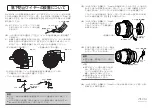
Why do some gases absorb infrared energy?
17
Figure 17.6
Styrene (C
6
H
5
CH=CH
2
), 16 atoms per molecule
Their increased degrees of mechanical freedom allow multiple rotational and vibrational
transitions. Because they are built from multiple atoms, they can absorb and emit heat
more effectively than simple molecules. Depending on the frequency of the transitions,
some of them fall into energy ranges that are located in the infrared region where the infra-
red camera is sensitive.
Transition type
Frequency
Spectral range
Rotation of heavy molecules
10
9
–10
11
Hz
Microwaves, above 3 mm/0.118
in.
Rotation of light molecules and
vibration of heavy molecules
10
11
–10
13
Hz
Far infrared, between 30 μm and
3 mm/0.118 in.
Vibration of light molecules.
Rotation and vibration of the
structure
10
13
–10
14
Hz
Infrared, between 3 μm and 30
μm
Electronic transitions
10
14
–10
16
Hz
UV–visible
In order for a molecule to absorb a photon via a transition from one state to another, the
molecule must have a dipole moment capable of briefly oscillating at the same frequency
as the incident photon. This quantum mechanical interaction allows the electromagnetic
field energy of the photon to be “transferred” or absorbed by the molecule.
FLIR Systems cameras take advantage of the absorbing nature of certain molecules, to
visualize them in their native environments.
FLIR Systems focal plane arrays and optical systems are specifically tuned to very narrow
spectral ranges, in the order of hundreds of nanometers, and are therefore ultra selective.
Only gases absorbent in the infrared region that is delimited by a narrow band pass filter
can be detected.
Since the energy from the gases is very weak, all camera components are optimized to
emit as little energy as possible. This is the only solution to provide a sufficient signal-to-
noise ratio. Hence, the filter itself is maintained at a cryogenic temperature: down to 60 K
in the case of the FLIR Systems LW camera that was released in the beginning of 2008.
Below, are the transmittance spectra of two gases:
• Benzene (C
6
H
6
)—absorbent in the MW region
• Sulfur hexafluoride (SF
6
)—absorbent in the LW region.
#T559899; r. AB/35742/35742; en-US
31
Содержание G300 A
Страница 1: ...User s manual FLIR G300 a...
Страница 2: ......
Страница 3: ...User s manual FLIR G300 a T559899 r AB 35742 35742 en US iii...
Страница 4: ......
Страница 29: ...Mechanical drawings 14 T559899 r AB 35742 35742 en US 23...
Страница 31: ...CE Declaration of conformity 15 T559899 r AB 35742 35742 en US 25...
Страница 32: ......
Страница 65: ......
Страница 67: ......
















































